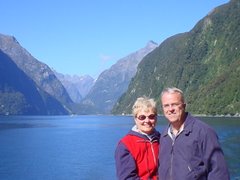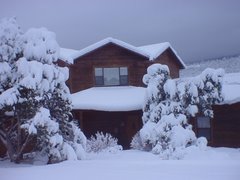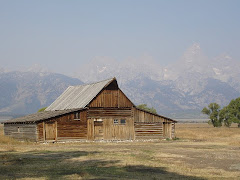Heading West. Had two planned side trips today. First, not far west and north of Watford City, just barely still in ND, is the confluence of the Yellowstone and Missouri Rivers. (Always wanted to use the word, confluence.) One of the educational signs at the site said this is one of the few, and maybe the only, place in the country where two major rivers “conflue” and there’s not a settlement there. (Just thinking about it, I think the confluence of the Green and Colorado Rivers also qualifies. The Rio Grande and the Pecos - small towns. Others? An exercise for the reader.)
Here's an aerial view of the confluence: Yellowstone on the left, Missouri on the right.

My bankside shot:

I shot a short video that conveys the power of these rivers flowing by -- like a very large snake slithering through the brush. The file is apparently too large to upload into blogger. You would have enjoyed it.
Speaking of enjoyment, Susie got the first thrill at the site of the confluence. Periodically, she swears off Cokes, but that is a periodic thing because periodically she decides that she's just got to have one. I've been instructed to stop her, unless she says, Not this time! Cokes were hard to find in Minnesota and they've been hard to find in restaurants across the Dakotas because Pepsi products are all that is sold. This day, we were in a period of "I've got to find a Coke." That led to this scene adjacent to the parking lot at the Confluence Center:
Back in the frontier days, Yellowstone-Missouri confluence was a rendezvous for trappers, traders, and tribes - no Coca-Cola, or Pepsi; maybe their equivalents.
Leaving the Confluence we made our first mistake of the day – there would be more (he said ominously). Map showed a road arcing NW to join US 2, our main route for the day. Didn’t look at the road symbol carefully enough and it turned out that this would be 16 miles of gravel and washboard. After a couple of slow miles debating about whether to unhook and turn around (the road was wide enough to jockey Tuzi through an up and back U-turn) we came across a spot where there was a dirt track running between the road and a RR and there were access points about 200 yards apart. The track (that we would drive on, not the RR one) was dry and smooth, so we took the opportunity and turned around and got back to US 2 by angling back to the NE.
Some time later, Susie says, There’s something wrong with one of our blinds. The pleats won’t stay pleated and I can’t raise the blind. She had noticed the blind flapping, a result of us not closing the window when we left the campground this morning. ‘Twas a windy day and at some point the angle got just right for the wind to abuse the blind. Closer inspection showed that a couple of strings that hold the blind together and enable it to be raised and lowered had broken. These are double-layer blinds and from having a string break once before I knew it was not something that could be fixed by tying a couple of Boy Scout knots (though neither of us was a Boy Scout). But, it is still pretty functional, so we'll live with it. Just a minor irritation. More to come. Dum dum dum dum, dum dum dum dum (think Jaws, not lack of intelligence).
Next stop: the
Fort Peck Dam. This dam on the Missouri was built in the 1930s - a stimulus project for your grandparents. I was introduced to the project through a book,
Bucking the Sun, by Ivan Doig, a Montana author. As I recall, it's one of those rip-roaring, dysfunctional family, historical novels. I thought it was one of our book club selections, but I don't find it listed; two other Doig books are, one of them well down our list. But, that's got nothing to do with Fort Peck.
Anyhow, it's a really big dam. (Which reminds me that in my youth in Manhattan, KS, a dam planned near there was denounced by opponents as Big Dam Foolishness. It did get built.) Here's an aerial view from the web:

Here's what it looks like when you drive across the dam behind a bug-streaked windshield.

Look, Ma! No hands!
In early evening we get to our destination of Havre (pronounced as in I don't want 'er, you can have 'er, she's too ... ). It's been our longest day, 416 miles, a lot of it pretty barren - the green prairies of ND have given way to browner and scrubbier country, not quite redeemable by the Big Sky. I've asked Susie to call the Good Sam-listed RV park in Havre to see if they have space available. Neither of us realize that there are two Good Sam parks there - they're on different pages in our TL Guide. The one Susie talked to said we've got one spot, but it's a little muddy. Once we figure out which park we talked to we decide we'll check the other park first -- it's on the way. We have the address, the intersection is identified, the GPS has the address, the highway runs right by it. But, we don't see it on first pass. We circle back through narrow residential streets with overhanging-trees, but still don't see it. One potential problem is that Havre, like several other towns we've seen up here, has numbered streets running N-S, numbered Avenues running E-W. Or, maybe the other way. Also, you can have, say, two First Streets - First Street N and First Street S, running east and west. Got it? We give up on door number one and drive on past town about four miles to the other park. It's pretty ugly. I'd have to back in from a difficult angle, squeeze between a tree and a mud puddle and rock over ruts left by the previous occupant. Nice lady at the park says maybe you want to try somewhere else.
So, we call park number one and get clear directions to it. It was at the intersection we thought, but the dominant signs are for a casino and you can't see RVs from the road. So, we didn't see it when we looked at it. Back to town. We find the casino/RV park. The park has an unusual layout. "Pull-thrus" are essentially parallel parking slots alongside a curb. The water and electric outlets are on the opposite side they usually are -- opposite from the connections on RVs. But, power cord and water hose will reach, so it works OK. Kind of makes sense after you get used to it.
We try a couple of the slots (parking, not casino). There are trees on our south side, blocking satellite access, which is impotant to me tonight because I'm wanting to watch the Texas/LSU baseball championship game, which has already started. No dice. Can't find an alignment. I think it's particularly difficult up here because the broadcasting satellite is at very low angle. No cable option, either, as we've generally found up north in small towns. Susie brightly and correctly suggests that maybe the casino would be showing the game. Another plan B. So, we hook up the water and electricity and I head over to check on the game - bartender helpfully turns on the game for me. I watch the half-inning in which LSU gets a big lead, then head back to Tuzi and Susie.
Now, here's the scene that keeps replaying in my mind. I look up the driveway that circles the RV park and I see Susie standing there in the driveway, holding what appears to be a basement compartment door and peering into that compartment which is where the water and sewer connections are. She seems composed, but perplexed. I walk up, not dash, and have given myself enough time to think how I should frame a question. So, I say, What happened? Not, WHAT DID YOU DO?
Susie had been inside Tuzi and a neighbor knocked and said Did you know there's water running out of your coach? Well, no. Susie shuts off the park's spigot, then goes around to the aforementioned basement compartment, because water is still running, and opens the door. Somehow it falls off its hinge. She managed to catch the door, it's heavy, so it didn't bang on to her toes or the pavement.
What happened was that there are two valve positions for the hose running into Tuzi. One is to fill the storage tank; one is for city water connection directly to our faucets, etc. Normally, while traveling I set the valve in the latter position. That morning, leaving Watford City, I hadn't (just like neither one of us checked that the windows were closed). If the hose connection had been on the usual driver-side, just as soon as I connected and turned on the water I would have heard the water flowing into the tank and I would have switched the valve to the city water position. This time, on the opposite side, I turned on the water, didn't hear and didn't check, and headed for the casino TV. Thus, the on-board water tank soon overflowed. Thankfully, the Tuzi plumbing is designed so that the overflow drains to the pavement; it doesn't flood the coach interior or basement.
Anyhow, with some help from fellow campers, we straightened out bent portions of the door hanger - it's not really a hinge - and got it back on and it seems to work OK. Had a little paint damage from a corner of the falling door gouging the side of Tuzi, but pretty minor.
Tomorrow we're off to Great Falls for the weekend.
Cheers,
Susie and Rob




































 Look, Ma! No hands!
Look, Ma! No hands!





















